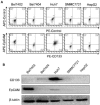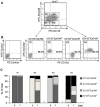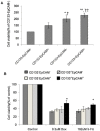CD133(+)EpCAM(+) phenotype possesses more characteristics of tumor initiating cells in hepatocellular carcinoma Huh7 cells
- PMID: 22904667
- PMCID: PMC3421230
- DOI: 10.7150/ijbs.4454
CD133(+)EpCAM(+) phenotype possesses more characteristics of tumor initiating cells in hepatocellular carcinoma Huh7 cells
Abstract
Background: EpCAM or CD133 has been used as the tumor initiating cells (TICs) marker in hepatocellular carcinoma (HCC). We investigated whether cells expressing with both EpCAM and CD133 surface marker were more representative for TICs in hepatocellular carcinoma Huh7 cells.
Methods: Four different phenotypes of CD133(+)EpCAM(+), CD133(+)EpCAM(-), CD133(-)EpCAM(+) and CD133(-)EpCAM(-) in Huh7 cells were sorted by flow cytometry. Then cell differentiation, self-renewal, drug-resistance, spheroid formation and the levels of stem cell-related genes were detected to compare the characteristics of TICs. The ability of tumorigenicity was measured in nonobese diabetic/severe combined immunodeficient (NOD/SCID) mice to verify TICs.
Results: CD133(+)EpCAM(+) cells have many characteristics of TICs in Huh7 cells compared with CD133(+)EpCAM(-), CD133(-)EpCAM(+), CD133(-)EpCAM(-) cells, including enrichment in side population cells, higher differentiation capacity, increased colony-formation ability, preferential expression of stem cell-related genes, appearance of drug-resistant to some chemotherapeutics, more spheroid formation of culture cells and stronger tumorigenicity in NOD/SCID mice.
Conclusion: CD133(+)EpCAM(+) phenotype is precisely represented TICs in Huh7 cells. It might be useful for studying biology mechanism of TICs in hepatocellular carcinoma and screening new targets for cancer therapy.
Keywords: CD133; EpCAM.; Hepatocellular carcinoma; Tumor initiating cells.
Conflict of interest statement
Competing Interests: The authors have declared that no competing interest exists.
Figures







Similar articles
-
A Novel Function for KLF4 in Modulating the De-differentiation of EpCAM-/CD133- nonStem Cells into EpCAM+/CD133+ Liver Cancer Stem Cells in HCC Cell Line HuH7.Cells. 2020 May 12;9(5):1198. doi: 10.3390/cells9051198. Cells. 2020. PMID: 32408542 Free PMC article.
-
miR-130b Promotes CD133(+) liver tumor-initiating cell growth and self-renewal via tumor protein 53-induced nuclear protein 1.Cell Stem Cell. 2010 Dec 3;7(6):694-707. doi: 10.1016/j.stem.2010.11.010. Cell Stem Cell. 2010. PMID: 21112564
-
Characterization and propagation of tumor initiating cells derived from colorectal liver metastases: trials, tribulations and a cautionary note.PLoS One. 2015 Feb 6;10(2):e0117776. doi: 10.1371/journal.pone.0117776. eCollection 2015. PLoS One. 2015. PMID: 25658706 Free PMC article.
-
EpCAM and its potential role in tumor-initiating cells.Cell Adh Migr. 2012 Jan-Feb;6(1):30-8. doi: 10.4161/cam.18953. Cell Adh Migr. 2012. PMID: 22647938 Free PMC article. Review.
-
Relevant markers of cancer stem cells indicate a poor prognosis in hepatocellular carcinoma patients: a meta-analysis.Eur J Gastroenterol Hepatol. 2013 Sep;25(9):1007-16. doi: 10.1097/MEG.0b013e32836019d8. Eur J Gastroenterol Hepatol. 2013. PMID: 23478672 Review.
Cited by
-
The inhibition of ABCB1/MDR1 or ABCG2/BCRP enables doxorubicin to eliminate liver cancer stem cells.Sci Rep. 2021 May 24;11(1):10791. doi: 10.1038/s41598-021-89931-9. Sci Rep. 2021. PMID: 34031441 Free PMC article.
-
Insights into an NEk2 inhibitory profile of nitidine chloride by molecular docking and biological evaluation.BMC Chem. 2022 Oct 9;16(1):75. doi: 10.1186/s13065-022-00870-6. BMC Chem. 2022. PMID: 36210464 Free PMC article.
-
MicroRNA-1305 Inhibits the Stemness of LCSCs and Tumorigenesis by Repressing the UBE2T-Dependent Akt-Signaling Pathway.Mol Ther Nucleic Acids. 2019 Jun 7;16:721-732. doi: 10.1016/j.omtn.2019.04.013. Epub 2019 Apr 22. Mol Ther Nucleic Acids. 2019. PMID: 31128423 Free PMC article.
-
Lidamycin decreases CD133 expression in hepatocellular carcinoma via the Notch signaling pathway.Oncol Lett. 2017 Dec;14(6):7889-7895. doi: 10.3892/ol.2017.7248. Epub 2017 Oct 20. Oncol Lett. 2017. PMID: 29344233 Free PMC article.
-
Regulatory Functions of microRNAs in Cancer Stem Cells: Mechanism, Facts, and Perspectives.Cells. 2025 Jul 14;14(14):1073. doi: 10.3390/cells14141073. Cells. 2025. PMID: 40710326 Free PMC article. Review.
References
-
- Dudeck O, Ricke J. Advances in regional chemotherapy of the liver. Expert Opin Drug Deliv. 2011;8:1057–1069. - PubMed
-
- Jemal A, Bray F, Center MM. et al. Global cancer statistics. CA Cancer J Clin. 2011;61:69–90. - PubMed
-
- Zhou BB, Zhang H, Damelin M. et al. Tumour-initiating cells: challenges and opportunities for anticancer drug discovery. Nat Rev Drug Discov. 2009;8:806–823. - PubMed
-
- Singh SK, Hawkins C, Clarke ID. et al. Identification of human brain tumour initiating cells. Nature. 2004;432:396–401. - PubMed
Publication types
MeSH terms
Substances
LinkOut - more resources
Full Text Sources
Research Materials
Miscellaneous

